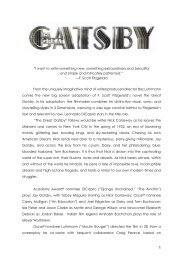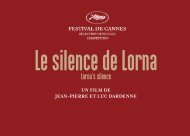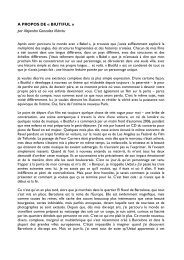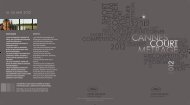Les Films du Lendemain and My New Picture present - Festival de ...
Les Films du Lendemain and My New Picture present - Festival de ...
Les Films du Lendemain and My New Picture present - Festival de ...
Create successful ePaper yourself
Turn your PDF publications into a flip-book with our unique Google optimized e-Paper software.
<strong>Les</strong> <strong>Films</strong> <strong>du</strong> <strong>Len<strong>de</strong>main</strong> <strong>and</strong><br />
<strong>My</strong> <strong>New</strong> <strong>Picture</strong> <strong>present</strong>
WORLD SALES<br />
FILMS DISTRIBUTION<br />
34 rue <strong>du</strong> Louvre<br />
75001 Paris France<br />
Tél.: +33 1 53 10 33 99<br />
Fax: +33 1 53 10 33 98<br />
info@filmsdistribution.com<br />
www.filmsdistribution.com<br />
INTERNATIONAL PRESS<br />
RENDEZ-VOUS<br />
Viviana Andriani<br />
25 fbg Saint Honoré<br />
75008 Paris France<br />
Tél./Fax: +33 1 42 66 36 35<br />
IN CANNES: +33 6 80 16 81 39<br />
viviana@rv-press.com<br />
www.rv-press.com<br />
2011 France Color 2h05 35 mm 1.85 Dolby SRD<br />
FRENCH RELEASE: SEPTEMBER 21 ST 2011<br />
Photos <strong>and</strong> Press book to download from: www.rv-press.com<br />
<strong>Les</strong> <strong>Films</strong> <strong>du</strong> <strong>Len<strong>de</strong>main</strong> <strong>and</strong><br />
<strong>My</strong> <strong>New</strong> <strong>Picture</strong> <strong>present</strong>
SYNOPSIS<br />
The dawn of the XXth century: L'Apolloni<strong>de</strong>, a house of tolerance,<br />
is living its last days.<br />
In this closed world, where some men fall in love <strong>and</strong> others<br />
become viciously harmful, the girls share their secrets, their<br />
fears, their joys <strong>and</strong> their pains...
CONVERSATION BETWEEN BERTRAND BONELLO AND LAURE ADLER 1<br />
Avril 2011<br />
GENESIS<br />
LAURE ADLER: How did the <strong>de</strong>sire to make a movie about<br />
what was once called a house of tolerance come to you?<br />
BERTRAND BONELLO: Ten years ago, I wanted to make a<br />
film on the reopening of brothels today. Then I gave up.<br />
After filming ON WAR, my last film, I really wanted to make<br />
a film with a group of girls, the dynamics of a group. It is<br />
my partner (Josée Deshaies), who is also my director of<br />
photography, who suggested that I go back to the i<strong>de</strong>a of<br />
brothels but treated from a historical st<strong>and</strong>point. I then<br />
started researching the subject <strong>and</strong> stumbled upon your<br />
book, it was the first one I read. I’m interested in the closed<br />
world aspect. Whenever there is a closed world, it can<br />
become a fictitious world, a world for cinema. Then it was<br />
up to me to work between document <strong>and</strong> fiction, between<br />
a chronicle <strong>and</strong> a narrative.<br />
The re<strong>present</strong>ation of the prostitute has always come to us<br />
through the eyes of men: most are painters or writers who<br />
went to brothels, <strong>and</strong> then came home to work on a<br />
painting or a book. The prostitute’s point of view has<br />
always been extremely difficult to find.<br />
LA: Therefore, they elu<strong>de</strong> us! And it is just as well. They do<br />
also truly elu<strong>de</strong> us when they are alive.<br />
BB: There is something profoundly mysterious about them,<br />
<strong>and</strong> this is why they have been a recurring figure in fiction<br />
writing since the beginning of art history. The first film<br />
which features a prostitute was ma<strong>de</strong> in 1900; it just goes<br />
to show that they became a character literally as soon as<br />
cinema was invented.<br />
THE HOUSE OF TOLERANCE<br />
LA: You <strong>de</strong>pict admirably the fact that the brothel was a<br />
place for socializing, meaning that before going up to the<br />
rooms, people waited, talked <strong>and</strong> drank.<br />
BB: Some men didn’t even go up to the bedrooms; they just<br />
came to have a drink.<br />
1. Laure Adler is the author of Daily Life in the Bor<strong>de</strong>llos of Paris, 1830-1930,<br />
published by Welcome Rain Publishers, 2002, USA.<br />
LA: What is very interesting in your film is the specific role<br />
of the upstairs <strong>and</strong> the downstairs. The latter is a<br />
sumptuous space, a beautiful background to enhance the<br />
beauty of the young women who are here to quench the<br />
sexual appetites of the bourgeois. But the brothel is a<br />
prison as well. There is the upstairs, where they live a<br />
barren life, <strong>and</strong> the downstairs, where they have to play<br />
their role.<br />
How did you manage to lead us on this journey - which is<br />
both dream-like <strong>and</strong> real – through this closed space that<br />
is the brothel?<br />
BB: I would tell the actresses: “you are like actresses going<br />
on a theater stage.” I tried to divi<strong>de</strong> up the space into three<br />
parts: the salons, the bedrooms <strong>and</strong> what I call the kitchen.<br />
I wanted to keep this balance, without setting priorities.<br />
We managed to shoot in just one set. This way, in one shot,<br />
we go from the attic, where they sleep, to the much more<br />
luxurious corridor leading to the rooms where they work. I<br />
wanted to show that this coexisted, that they were only<br />
one door away from wearing either a simple night gown or<br />
a magnificent dress with dreamy costume jewelry. It is a<br />
film about contrasts.<br />
TO SEE AND BE SEEN<br />
LA: A rather enigmatic character, to whom something<br />
awful happens, starts <strong>and</strong> finishes the film. As is often the<br />
case in your movies, we broach the question of “seeing <strong>and</strong><br />
being seen”.<br />
BB: It is also about the body <strong>and</strong> the mind, <strong>and</strong> the way one<br />
affects the other.<br />
I think I was br<strong>and</strong>ed for life by Cronenberg’s films because<br />
he only talks about this: the way the relation with the body<br />
is going to influence the mind. Sometimes leading to<br />
madness. To come back to the character you mentioned;<br />
while I was writing the screenplay, I dreamt two or three<br />
nights in a row about THE MAN WHO LAUGHS a 1920s<br />
adaptation of Victor Hugo’s novel. Then I thought I was<br />
going to try <strong>and</strong> create the laughing woman.
LA: Your film is a story within a story for cinema.<br />
BB: <strong>My</strong> director of photography also thinks that this is the<br />
way all my films are. In truth, one could say that the<br />
character played Noémie Lvovsky is me, the director,<br />
directing this brothel, she <strong>de</strong>signs her sets, she asks the<br />
prefect for help the way I ask the CNC for money… <strong>and</strong><br />
maybe you could consi<strong>de</strong>r that her client is my audience…<br />
LA: So it’s not by chance, I imagine, that the main<br />
characters like the brothel’s madam <strong>and</strong> the main clients<br />
are played by moviemakers.<br />
BB: I realized this very late into the process! It is a bit by<br />
chance. For one thing, I think these moviemakers are good<br />
actors. All at once, we were in a room <strong>and</strong> realized there<br />
were ten of us! Why so many directors? I don’t know;<br />
somehow it must be my way of talking about cinema.<br />
THE GIRLS, A COLLECTIVE BODY<br />
LA: What is fascinating is that the girls are seen by the<br />
madam, a woman <strong>and</strong> a master, who watches her<br />
boar<strong>de</strong>rs. In the end, the men are somewhat like the girls’<br />
slaves; the girls win over their clients.<br />
BB: Yes, I absolutely do believe it is so. The woman-master<br />
is a jail-keeper.<br />
The harshness comes from the house itself, the jail <strong>and</strong> the<br />
living conditions.<br />
With my director of photography, we chose to film only the<br />
girls. Sometimes the men are seen from the back, or their<br />
head is cut off by the frame. There are, therefore, very few<br />
counter shot scenes, we stay with the girls, <strong>and</strong> if we turn<br />
around, it’s the girl who is in the frame as well.<br />
LA: And when there is a close-up of a man, it’s a mask.<br />
BB: Exactly, <strong>and</strong> it reinforces the impression that the<br />
prostitute is above the client. I told the actresses: “Be<br />
careful, I want twelve intelligent girls.” It was really<br />
important for me: they’re not being fooled, they are strong<br />
women.<br />
LA: In any case, they are very dignified, very irreverent,<br />
very insolent, <strong>and</strong> very luminous; they know who they are.<br />
They are also slaves who will fight for the abolition of<br />
slavery. They know they can die from their work.<br />
One of them manages to escape, it’s important that one of<br />
the girls makes it out, because being a prostitute is not<br />
one’s <strong>de</strong>stiny.<br />
BB: She manages to escape because she does so early on.<br />
It is truly a matter of time. In<strong>de</strong>ed, after one year, their<br />
<strong>de</strong>bts are too heavy for them to leave. It isn’t a <strong>de</strong>stiny but<br />
one need to be clear-sighted. Clear-sightedness, here,<br />
comes from a very young girl who arrives, quickly<br />
un<strong>de</strong>rst<strong>and</strong>s the situation <strong>and</strong> leaves before it’s too late.<br />
LA: She looks like she stepped out of a Renoir painting.<br />
BB: Her hair, her skin, her body, yes. It’s really hard to find<br />
girls who look that way, now.<br />
LA: How did you choose the girls?<br />
BB: It was a lengthy process. It took almost nine months.<br />
First, we had to find girls who embodied a form of<br />
mo<strong>de</strong>rnity in or<strong>de</strong>r not to emphasize the reconstitution<br />
aspect, all the while being able to travel in time, back to<br />
1900. I had my mind set on a mix, professional <strong>and</strong> nonprofessional<br />
actresses, as well as a mix of training <strong>and</strong><br />
e<strong>du</strong>cational backgrounds. At the same time, this mix <strong>and</strong><br />
this diversity had to lead to the consistency of the group.<br />
The girls had to work together, in a synergy. I was far more<br />
obsessed by the i<strong>de</strong>a of forming a group than that of<br />
having a leading role.<br />
Yet, above all, I think that the choice was gui<strong>de</strong>d by the<br />
fact that each of the actresses, as a person, is interesting<br />
to me. Sometimes, you don’t even know why, but a girl<br />
enters a room <strong>and</strong> you think: that’s her. Even before you<br />
shoot screen tests.<br />
LA: It is a collective body.<br />
BB: It was really important for me not to make a choral<br />
film, with characters <strong>and</strong> extras. I wanted to treat the six<br />
leading roles <strong>and</strong> the others in the same manner. I put the<br />
same effort into choosing them, <strong>and</strong> directing them.
LA: All the actresses in your film look like sitting mo<strong>de</strong>ls,<br />
from paintings by Manet, Monet <strong>and</strong> Courbet. Is this why<br />
you wanted them to come out of the house’s space to let<br />
them breathe, in every meaning of the term?<br />
BB: It was important to take the spectator outsi<strong>de</strong> in or<strong>de</strong>r<br />
to better feel, afterwards, the prison-like atmosphere back<br />
insi<strong>de</strong> the brothel. I imagined what it would be like, for a<br />
prostitute, to go to the country with the madam once a<br />
month, or every other month.<br />
LA: And then it shows the girls’ innocence, because they<br />
are completely surroun<strong>de</strong>d by this protective nature.<br />
BB: I told them: “Forget the prostitutes, be young women.”<br />
Something like joy <strong>and</strong> innocence permeated the scene.<br />
DESIRES AND FANTASIES<br />
LA: You may find this surprising but for me it’s a film about<br />
faces. Even though the body is an important subject matter<br />
in the film, the question of the face keeps recurring, almost<br />
hauntingly.<br />
BB: Regarding the bodies, I thought a lot about the<br />
following: what ought to be shown in the bedroom<br />
sequences? I wanted to avoid the classic sex scenes, <strong>and</strong><br />
also, once again, show things from their point of view. This<br />
is why, then, the faces imposed themselves, in<strong>de</strong>ed…<br />
LA: You found ways of filming the clients’ <strong>de</strong>sire without<br />
showing sexual intercourse. It is a very chaste film.<br />
BB: Very mo<strong>de</strong>st. I aimed for bedroom sequences that are<br />
theater-like, <strong>and</strong> fetishistic. Almost Buñuel-style. There is<br />
very little nudity because it’s rather close to the truth; they<br />
had wi<strong>de</strong>ly slit un<strong>de</strong>rgarments. Men didn’t undress much<br />
either, it took too much time. People would make love all<br />
dressed.<br />
Therefore what we see more are the fantasies that the<br />
men want to see embodied: “I want a geisha…, I want a<br />
doll…” The fantasies reveal as much about sex as seeing<br />
bodies being thrust in a simulated act in front of the<br />
camera. This can sometimes be conveyed by a perverted<br />
look but there are also games, like the bathtub filled with<br />
champagne, for instance…<br />
I wanted to work on the theater-like implication of the<br />
moment when the door to the brothel is closed, <strong>and</strong> the<br />
client enters.<br />
LA: In<strong>de</strong>ed it was a theater. But it is a painter’s film too.<br />
BB: We looked at many paintings, the framing <strong>and</strong><br />
composition, the color balance, the poses…<br />
LA: Manet, Monet, Renoir?<br />
BB: Among others, <strong>and</strong> there are numerous others, not<br />
nearly as good; yet everything was interesting to me. As far<br />
as the time period is concerned, I am very attached to<br />
specific <strong>de</strong>tails, far more than to the wi<strong>de</strong>r i<strong>de</strong>a of a<br />
reconstitution.<br />
LA: It is a film about fantasy <strong>and</strong> fantasy is particularly<br />
hard to re<strong>present</strong>. A sequence recurs in an insistent<br />
manner; it is the sequence played by Louis-Do <strong>de</strong><br />
Lencquesaing, who keeps wanting to look – much like<br />
Courbet – insi<strong>de</strong> the vagina of a woman. Your film also<br />
talks about the inseparable link between prostitution <strong>and</strong><br />
maternity.<br />
BB: Yes. He says: “I want to see the insi<strong>de</strong> of your sex to be<br />
able to paint your face.” As if this was where the soul could<br />
be seen. Were they maternal? Probably a little. I see all<br />
these men as somewhat lost. For instance, I like the<br />
moment when the character played by Louis-Do simply can<br />
no longer force himself to go home.<br />
LA: But a brothel was not a pension, <strong>and</strong> therefore he has<br />
to leave. The house of tolerance is a place that is<br />
reassuring for men when it comes to their virility but also<br />
from a social st<strong>and</strong>point.<br />
BB: The English had their Men’s Clubs, we had the brothels.<br />
LA: This sociability between men mirrors the solidarity<br />
between the girls.
BB: I wanted the girls to st<strong>and</strong> together, even if there are<br />
rivalries. This is something you talk about in your book;<br />
they helped each other, there was no competition. I<br />
panicked a little the first two days of shooting but soon<br />
after, I felt that the solidarity was going to be there,<br />
between the girls, <strong>and</strong> that I was going to be able to film it.<br />
COSTUMES AND LIGHTING<br />
LA: The costumes are positively sublime, where did you<br />
find them?<br />
BB: I worked with a costume <strong>de</strong>signer (Anaïs Rom<strong>and</strong>) who<br />
is familiar with this time period. We didn’t have much<br />
money, so she advised me to concentrate on<br />
un<strong>de</strong>rgarment <strong>and</strong> corsets. She had every corset tailorma<strong>de</strong>.<br />
The sets, in the end, are fairly simple. As my director<br />
of photography said: “a diamond on black velvet”. So we<br />
put black velvet on the walls to offset the girls <strong>and</strong> make<br />
them shine even more.<br />
LA: The lighting of your film is that of fantasy, of <strong>de</strong>sire, a<br />
neo- Buñuel light.<br />
BB: I divi<strong>de</strong>d the entire film into two parts, both in terms of<br />
acting direction <strong>and</strong> light: day <strong>and</strong> night. It was really hard<br />
for the director of photography because there were no<br />
windows. She started from an i<strong>de</strong>a that I like: the advent of<br />
electricity. This way, downstairs, where luxury is, there are<br />
electrical lamps while upstairs there is no electricity, so<br />
they use c<strong>and</strong>les. Her real wish was more a dream than an<br />
i<strong>de</strong>a; she wanted the girls to be their own light.<br />
CREATING SPACE AND TIME<br />
BB: In the narrative construction, the first <strong>and</strong> third part<br />
somewhat mirror one another. The middle part, on the<br />
other h<strong>and</strong>, is almost like a chronicle.<br />
Also, there was no space for the girls since we couldn’t go<br />
out, so we had to create space within time. We played with<br />
time, simultaneity, flashbacks, two-way mirrors <strong>and</strong> split<br />
screens. The film unfolds a little like a round dance, with<br />
link shots <strong>and</strong> transitions; an i<strong>de</strong>a at the end of a scene<br />
becomes the beginning of the next one. The girls<br />
somewhat tag-team the narrative thread, <strong>and</strong> that’s how<br />
we filmed. Sometimes, we go back to a certain point to<br />
flesh it out or give another point of view.<br />
LA: There is a form of discontinuity in the narrative, yet just<br />
one temporality <strong>and</strong>, actually, just one tempo, like in jazz.<br />
THE MUSIC OF THE SOULS, A PRESENT-DAY<br />
FILM<br />
LA: You put contemporary music in the middle <strong>and</strong> at the<br />
end of the film. Is it to show the subject matter’s<br />
contemporaneity? Or is it to show it isn’t a period film?<br />
BB: What I am afraid of, with period films, is reconstitution.<br />
When I was writing the film, I listened to this soul music<br />
from the 60s <strong>and</strong> the soul of the black American singers<br />
always took me back to the girls.<br />
When one of them dies, they start singing an American<br />
slave song around her.<br />
We don’t have to use a string quartet just because we are<br />
in 1900. It wasn’t just to mo<strong>de</strong>rnize the i<strong>de</strong>a; it’s simply<br />
that these women evoked this music for me. Maybe it<br />
something about the connection with slavery.<br />
LA: With the new laws <strong>and</strong> proposals about making the<br />
clients pay taxes, you end up being right in synch with<br />
today’s news. The brothels are once again much talked<br />
about, <strong>and</strong> your film ends precisely with the shot of a<br />
hooker on the job on a street somewhere in some town<br />
today.<br />
BB: Yes, Porte <strong>de</strong> la Chapelle. At the end, one of the girls<br />
asks another: “What are you going to do now?” <strong>and</strong> the<br />
other answers “I don’t know.” One hundred years later,<br />
she’s still doing the same thing.<br />
For me, it was the i<strong>de</strong>a of fictional <strong>de</strong>stiny, one manages to<br />
escape while the other will be a hooker her whole life. I<br />
found it interesting to talk about the <strong>de</strong>stiny of a woman<br />
who will never escape even though she’s long dreamt she<br />
would.
ON FLESH<br />
LA: Then, there are also those who will end up meeting<br />
their maker; <strong>de</strong>ath is omni<strong>present</strong>.<br />
BB: Yes, there is a danger, syphilis, in particular.<br />
LA: There, you are also faithful to what happened then<br />
historically. The only men allowed insi<strong>de</strong> the brothel, asi<strong>de</strong><br />
from the clients, were the doctors. There is a sequence in<br />
the film where the girls have to open their legs, not to<br />
make money but to be examined by the doctor. In this<br />
sequence, it is blatant that they are young bodies meant<br />
for a business aimed at the bourgeoisie <strong>and</strong> that,<br />
therefore, these young bodies have to be clean <strong>and</strong><br />
healthy.<br />
BB: I think this sequence is very cruel. The doctor is played<br />
by a real gynecologist; when he started speaking his lines<br />
with his medical tone, my blood froze. The girls wait their<br />
turn, terrified: are they going to find out that they are<br />
pregnant? That they are sick?<br />
I wanted to make it a sequence about fear. We don’t see<br />
the doctor much, what we see are the girls’ faces as<br />
they’re waiting their turn, the verdict.<br />
If anyone finds anything political in this film, I’d like it to be<br />
through sequences like this one.<br />
LA: It was also the vice squad that was embodied by these<br />
doctors. In addition, it was one of the leading doctors at<br />
the time, Parent Duchâtelet, who invented the legal<br />
framework for brothels making medical visits m<strong>and</strong>atory,<br />
with a report for the prefecture. And I don’t believe it’s only<br />
a coinci<strong>de</strong>nce that the same man invented the Paris<br />
sewage system.<br />
MELANCHOLY AND DECADENCE<br />
LA: Deep down, I can’t help won<strong>de</strong>ring whether this isn’t a<br />
film about a lost paradise.<br />
BB: In<strong>de</strong>ed, a king of melancholy, of <strong>de</strong>ca<strong>de</strong>nce, in the<br />
etymological meaning of the term. There is also the<br />
darkness of Romanticism. The shot of the petal falling is<br />
an utterly romantic shot, but somewhat grotesque,<br />
because if it isn’t it becomes sentimentalism.<br />
LA: Concerning the i<strong>de</strong>a of <strong>de</strong>ca<strong>de</strong>nce that you mentioned,<br />
there is this scene where the Laughing woman is exhibited<br />
like a freak show figure. How did you conceive that scene?<br />
BB: Like something operatic. It’s a form of staging within<br />
the staging. There are only a few shots.<br />
The energy had to be entirely different from that of the<br />
brothel; it’s almost religious. I thought of paintings,<br />
pictorial re<strong>present</strong>ations. As for her, I thought of her as a<br />
marble statue, with her skin so white. The others are just<br />
<strong>de</strong>corum. We are insi<strong>de</strong> her head. It is all staged like an<br />
aristocratic show.<br />
LA: 1900. It was the transition from one century to<br />
another, a date when the brothels started <strong>de</strong>clining<br />
because the girls started working in the streets, taking<br />
over the si<strong>de</strong>walks.<br />
BB: The i<strong>de</strong>a was to show, without going outsi<strong>de</strong>, how<br />
Paris, France <strong>and</strong> the world were going to change.<br />
We un<strong>de</strong>rst<strong>and</strong> quickly that the brothel is going to close<br />
down. We are only witnessing the downfall of things <strong>and</strong><br />
the way the girls are slowly <strong>de</strong>teriorating. I think there’s<br />
nothing more touching than a form of beauty slowly<br />
withering, to never return… a slow fall from magnificence…<br />
a <strong>de</strong>sperate party. What these women go through so they<br />
won’t shatter to pieces.
BERTRAND BONELLO<br />
Bertr<strong>and</strong> Bonello was born in 1968. E<strong>du</strong>cated as a musician before<br />
becoming a filmmaker, he ma<strong>de</strong> his first feature film in 1998,<br />
QUELQUE CHOSE D’ORGANIQUE (Something Organic) for which he<br />
also wrote the screenplay <strong>and</strong> the music. The film was selected for<br />
the Berlin film festival in the “Panorama” section.<br />
In 2001, his second film, LE PORNOGRAPHE (The Pornographer) the<br />
portrait of a retired porno film maker interpreted by Jean-Pierre<br />
Léaud, was <strong>present</strong>ed at the International Critics’ week at the<br />
Cannes Film <strong>Festival</strong> <strong>and</strong> won the International Film Critics’ Fipresci<br />
Prize.<br />
In 2003, Bertr<strong>and</strong> Bonello directed TIRESIA, which was in<br />
competition in the Official Selection at the Cannes Film <strong>Festival</strong>.<br />
He returned to Cannes in 2005 with a film short in a special<br />
screening, CINDY THE DOLL IS MINE, with Asia Argento, a homage to<br />
the artist photographer, Cindy Sherman.<br />
In 2007, Bonello directed <strong>and</strong> pro<strong>du</strong>ced a new project, MY NEW<br />
PICTURE, <strong>present</strong>ed at Locarno Film Film <strong>Festival</strong>.<br />
Bertr<strong>and</strong> Bonello directed in 2008, DE LA GUERRE (On War), with<br />
Mathieu Amalric, selected at the Director’s Fortnight. In 2010, his<br />
short Where the boys are is selected at Locarno Film <strong>Festival</strong>.<br />
L’APOLLONIDE - Souvenirs <strong>de</strong> la maison close (House of tolerance) is<br />
his fifth long feature.<br />
FILMOGRAPHY<br />
2011 L’APOLLONIDE - Souvenirs <strong>de</strong> la maison close (House of tolerance)<br />
2008 DE LA GUERRE (On war)<br />
2003 TIRESIA<br />
2001 LE PORNOGRAPHE (The pornographer)<br />
1998 QUELQUE CHOSE D’ORGANIQUE (something organic)<br />
Shorts<br />
2010 WHERE THE BOYS ARE<br />
2006 MY NEW PICTURE<br />
2005 CINDY : THE DOLL IS MINE<br />
1997 THE ADVENTURES OF JAMES AND DAVID<br />
1996 QUI JE SUIS
NOÉMIE LVOVSKY<br />
After gra<strong>du</strong>ating from the Fémis, Noémie Lvovsky started as<br />
screen writer, working with Arnaud Desplechin on LA VIE DES<br />
MORTS (1991) <strong>and</strong> LA SENTINELLE (The Sentinel - 1992). In<br />
1994, she directed her first feature film OUBLIE-MOI (Forget<br />
Me) starring Valeria Bruni-Te<strong>de</strong>schi, with whom she later cowrote<br />
the screenplays for two films IL EST PLUS FACILE POUR UN<br />
CHAMEAU (It’s Easier for a Camel - 2003) <strong>and</strong> ACTRICES<br />
(Actresses - 2007).<br />
Her second feature film, LA VIE NE ME FAIT PAS PEUR (Life<br />
doesn’t Scare Me), received the Jean Vigo Prize in 1999. She<br />
then went on to make LES SENTIMENTS (Feelings - Louis Deluc<br />
Prize in 2003) <strong>and</strong> FAUT QUE ÇA DANSE (Let’s Dance) in 2007.<br />
Alongsi<strong>de</strong> her career as a director, she started acting in 2001 in<br />
Yvan Attal’s MA FEMME EST UNE ACTRICE (<strong>My</strong> Wife is an Actress).<br />
Afterwards, she was seen in several films, such as ROIS ET<br />
REINE (Kings & Queen) by Arnaud Desplechin (2004), L’UN<br />
RESTE, L’AUTRE PART (One Stays, One leaves) by Clau<strong>de</strong> Berri<br />
(2005), ACTRICES (Actresses) by Valeria Bruni-Te<strong>de</strong>schi (2007)<br />
<strong>and</strong> also LES BEAUX GOSSES (The French Kissers) by Riad<br />
Sattouf (2009). She is featured in Benoît Jacquot’s upcoming<br />
film, LES ADIEUX À LA REINE (Farewell, <strong>My</strong> Queen), 17 FILLES<br />
(17 girls) by Delphine & Muriel Coulin, PRESUME COUPABLE<br />
(Guilty) BY VINCENT GARENQ, <strong>and</strong> LE SKYLAB by Julie Delpy.
HAFSIA HERZI<br />
Her first movie role at age 20 in Ab<strong>de</strong>llatif Kechiche’s LA GRAINE ET LE MULET (The Secret of<br />
the Grain - 2007) allowed Hafsia Herzi to received honoring rewards such as the Acting Prize<br />
at the Venice Mostra as well as the Best Budding Actress Cesar.<br />
Since, she has worked for directors such as Raja Amari or Alain Guiraudie. She will soon be<br />
back on the screen in LE CHAT DU RABBIN (The Rabbi’s Cat) by Joan Sfar <strong>and</strong> LA SOURCE DES<br />
FEMMES (The Source) by Ra<strong>du</strong> Mihaileanu, also competing at the Cannes Film <strong>Festival</strong> this<br />
year.<br />
ADÈLE HAENEL<br />
Adèle Haenel obtained her first role at age 13 in LES DIABLES (The Devils) by Christophe<br />
Ruggia (2002). She <strong>de</strong>livered a particularly remarkable performance in 2007 in NAISSANCES<br />
DES PIEUVRES (Water Lilies) by Céline Sciamma, for which she received a Cesar nomination in<br />
2008. She will soon be seen in Valérie Mrejen <strong>and</strong> Bertr<strong>and</strong> Schefer’s EN VILLE (Iris in Bloom),<br />
as well as in APRÈS LE SUD by Jean-Jacques Jauffret, both <strong>present</strong>ed at the Directors’<br />
Fortnight this year.<br />
CÉLINE SALLETTE<br />
A gra<strong>du</strong>ate from the Conservatoire National Supérieur d’Art dramatique, Céline Sallette played<br />
her first part in a movie in 2004, in Philippe Garrel’s LES AMANTS RÉGULIERS (Regular Lovers).<br />
Then she starred in Patrick Granperret’s MEURTRIÈRES (Mur<strong>de</strong>rers - 2005). She was later<br />
featured in films like LE GRAND ALIBI (The Great Alibi) by Pascal Bonitzer or LA GRANDE VIE<br />
(The High Life) by Emmanuel Salinger. She is also featured in Philippe Garrel’s next film, UN<br />
ÉTÉ BRÛLANT.<br />
JASMINE TRINCA<br />
Jasmine Trinca started her career in cinema in 2001 with Nanni Moretti’s LA STANZA DEL<br />
FIGLIO (The Son’s Room), <strong>and</strong> worked again with him in 2006 for IL CAIMANO (The Caïman).<br />
She was also seen in LA MEGLIO GIOVENTU (The Best of Youth) by Marco Tullio Giordana<br />
(2003) or in Michele Placido’s films, ROMANZO CRIMINALE (Crime Novel - 2005) <strong>and</strong> IL GRANDE<br />
SOGNO (Le rêve italien - 2009), for which she received the Best Actress award at the Venice<br />
Film <strong>Festival</strong>.<br />
ALICE BARNOLE <strong>and</strong> ILIANA ZABETH are acting for the first time in a feature film.
CAST<br />
Hafsia Herzi Samira<br />
Céline Sallette Clotil<strong>de</strong><br />
Jasmine Trinca Julie<br />
Adèle Haenel Léa<br />
Alice Barnole Ma<strong>de</strong>leine<br />
Iliana Zabeth Pauline<br />
<strong>and</strong> Noémie Lvovsky Marie-France<br />
Judith Lou Levy<br />
Anaïs Thomas<br />
Pauline Jacquard<br />
Maïa S<strong>and</strong>oz<br />
Joanna Grudzinska<br />
Esther Garrel<br />
CREDITS<br />
Screenplay Bertr<strong>and</strong> Bonello<br />
Stage Director Bertr<strong>and</strong> Bonello<br />
Assistant Stage Director Elsa Amiel<br />
Cinematographer Josée Deshaies<br />
Editor Fabrice Rouaud<br />
Sound Jean-Pierre Duret, Nicolas Moreau, Jean-Pierre Laforce<br />
Set Decorator Alain Guffroy<br />
Costumes Anaïs Rom<strong>and</strong> AFCCA<br />
Make-up Laure Talazac<br />
Hair Ferouz Zaafour<br />
Music Bertr<strong>and</strong> Bonello<br />
Pro<strong>du</strong>ction Director Au<strong>de</strong> Cathelin<br />
Post-pro<strong>du</strong>ction Christina Crassaris<br />
Pro<strong>du</strong>ction Kristina Larsen (<strong>Les</strong> <strong>Films</strong> <strong>du</strong> <strong>Len<strong>de</strong>main</strong>)<br />
<strong>and</strong> Bertr<strong>and</strong> Bonello (<strong>My</strong> <strong>New</strong> <strong>Picture</strong>)<br />
A co-pro<strong>du</strong>ction ARTE FRANCE CINEMA. With the participation of ARTE France, CANAL +, CINECINEMA.<br />
With the participation of CENTRE NATIONAL DE LA CINEMATOGRAPHIE ET DE L’IMAGE ANIMÉE.<br />
With the support of RÉGION ILE-DE-FRANCE <strong>and</strong> the MEDIA programme of the European Union.<br />
In association with SOFICINEMA 6 DEVELOPPEMENT, SOFICINEMA 7 <strong>and</strong> CINEMAGE 5.<br />
World Sales <strong>Films</strong> Distribution.<br />
French distribution Haut et Court.<br />
Photos (except cover) © Carole Bethuel<br />
Design Soazig Petit<br />
Xavier Beauvois<br />
Louis-Do <strong>de</strong> Lencquesaing<br />
Jacques Nolot<br />
Laurent Lacotte

















